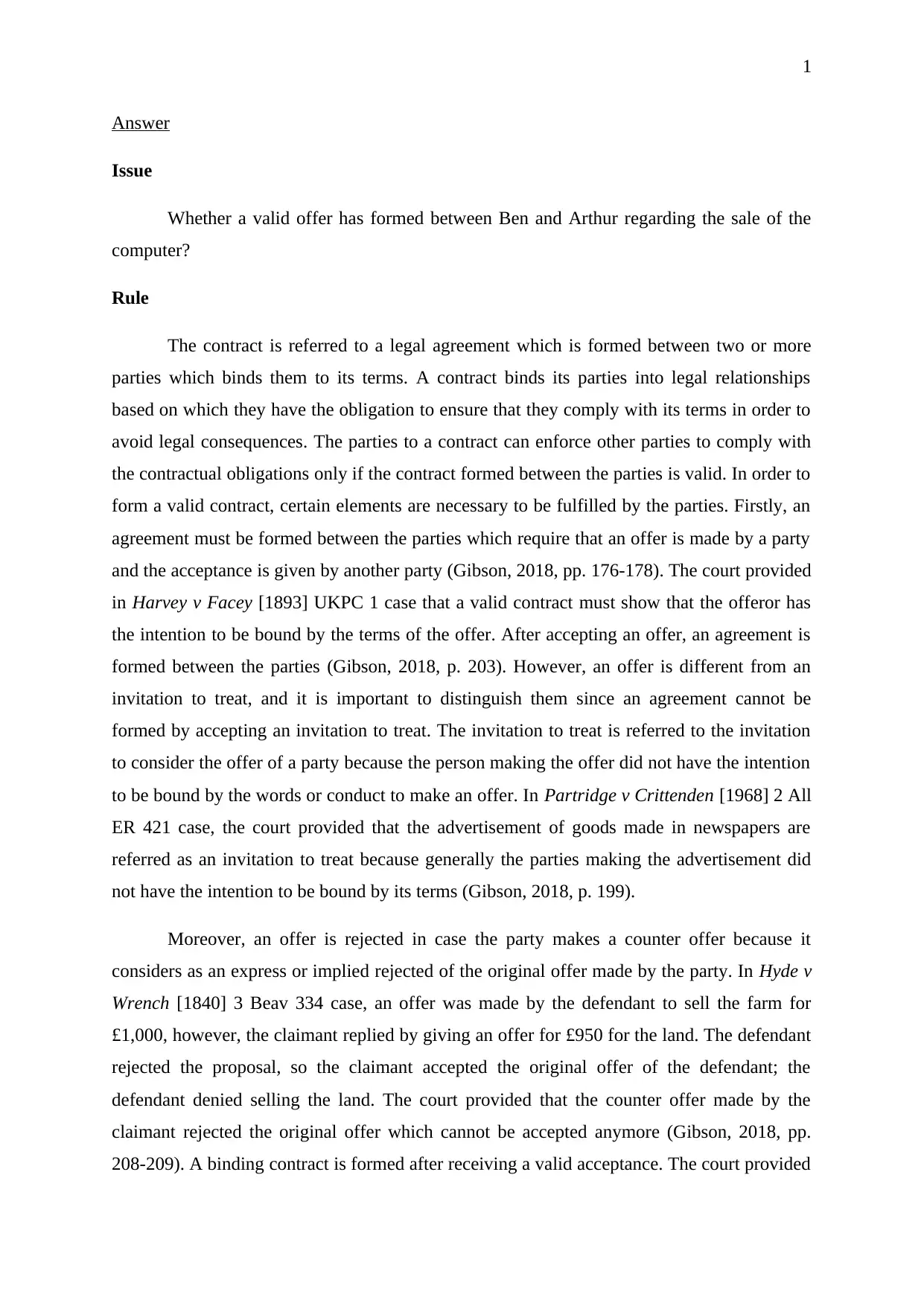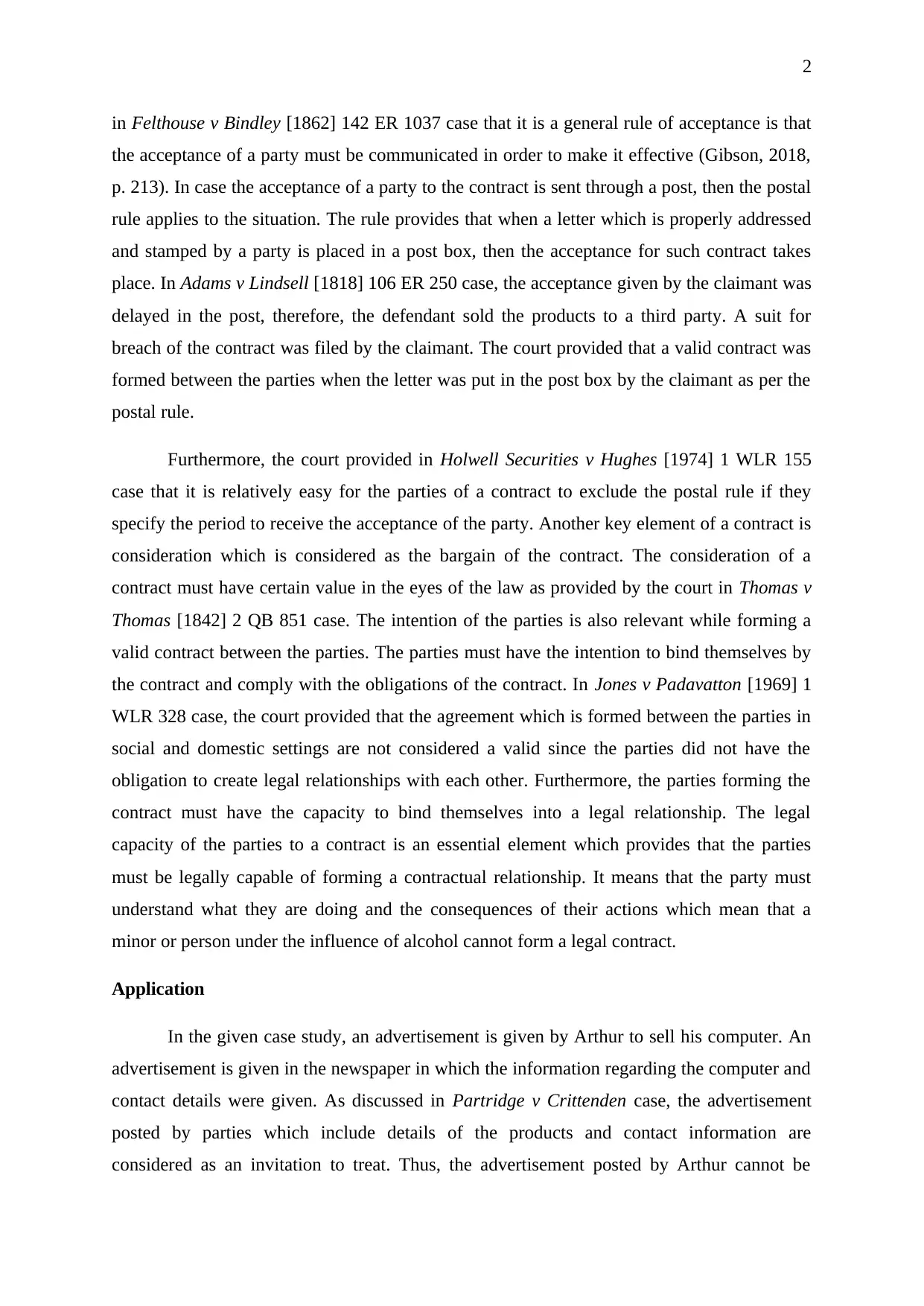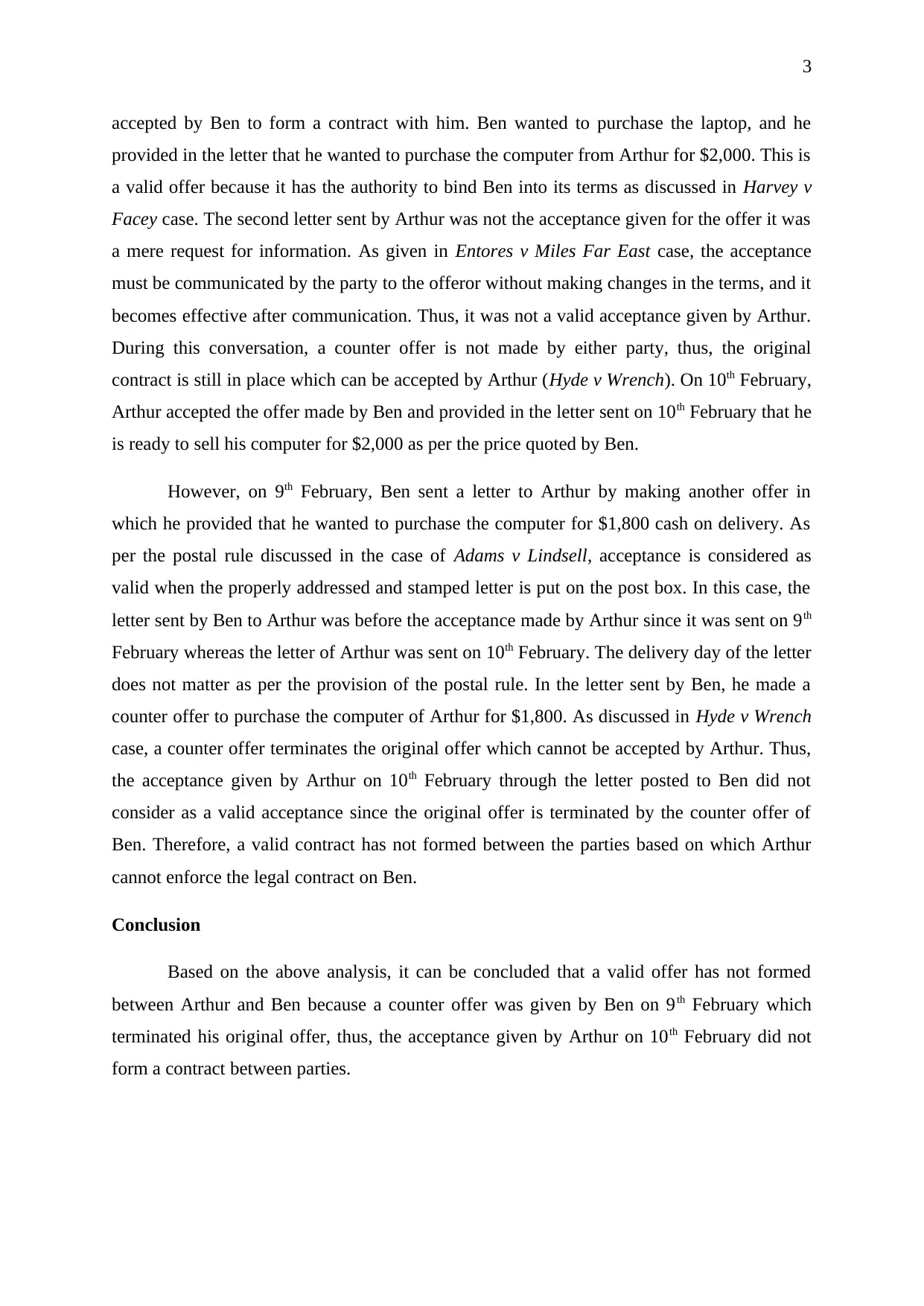Legal Problem Solving: Offer, Acceptance, and Contractual Validity
VerifiedAdded on 2023/06/07
|5
|1530
|437
Homework Assignment
AI Summary
This assignment solution addresses a legal problem concerning the formation of a contract between Ben and Arthur regarding the sale of a computer. The analysis follows the IRAC method, examining whether a valid offer was formed. The solution defines key legal concepts, including offer, acceptance, invitation to treat, and counteroffer, referencing relevant case law like Harvey v Facey, Partridge v Crittenden, and Hyde v Wrench. It evaluates the communications between Ben and Arthur, applying the postal rule as discussed in Adams v Lindsell. The solution concludes that a valid contract was not formed because Ben's counteroffer terminated his original offer. The assignment highlights the importance of clear communication and adherence to contract law principles. The solution also considers the legal capacity of the parties and the intention to create legal relations. Finally, the solution concludes that no valid contract was formed due to the counter offer.

0
Legal Problem Solving
Legal Problem Solving
Paraphrase This Document
Need a fresh take? Get an instant paraphrase of this document with our AI Paraphraser

1
Answer
Issue
Whether a valid offer has formed between Ben and Arthur regarding the sale of the
computer?
Rule
The contract is referred to a legal agreement which is formed between two or more
parties which binds them to its terms. A contract binds its parties into legal relationships
based on which they have the obligation to ensure that they comply with its terms in order to
avoid legal consequences. The parties to a contract can enforce other parties to comply with
the contractual obligations only if the contract formed between the parties is valid. In order to
form a valid contract, certain elements are necessary to be fulfilled by the parties. Firstly, an
agreement must be formed between the parties which require that an offer is made by a party
and the acceptance is given by another party (Gibson, 2018, pp. 176-178). The court provided
in Harvey v Facey [1893] UKPC 1 case that a valid contract must show that the offeror has
the intention to be bound by the terms of the offer. After accepting an offer, an agreement is
formed between the parties (Gibson, 2018, p. 203). However, an offer is different from an
invitation to treat, and it is important to distinguish them since an agreement cannot be
formed by accepting an invitation to treat. The invitation to treat is referred to the invitation
to consider the offer of a party because the person making the offer did not have the intention
to be bound by the words or conduct to make an offer. In Partridge v Crittenden [1968] 2 All
ER 421 case, the court provided that the advertisement of goods made in newspapers are
referred as an invitation to treat because generally the parties making the advertisement did
not have the intention to be bound by its terms (Gibson, 2018, p. 199).
Moreover, an offer is rejected in case the party makes a counter offer because it
considers as an express or implied rejected of the original offer made by the party. In Hyde v
Wrench [1840] 3 Beav 334 case, an offer was made by the defendant to sell the farm for
£1,000, however, the claimant replied by giving an offer for £950 for the land. The defendant
rejected the proposal, so the claimant accepted the original offer of the defendant; the
defendant denied selling the land. The court provided that the counter offer made by the
claimant rejected the original offer which cannot be accepted anymore (Gibson, 2018, pp.
208-209). A binding contract is formed after receiving a valid acceptance. The court provided
Answer
Issue
Whether a valid offer has formed between Ben and Arthur regarding the sale of the
computer?
Rule
The contract is referred to a legal agreement which is formed between two or more
parties which binds them to its terms. A contract binds its parties into legal relationships
based on which they have the obligation to ensure that they comply with its terms in order to
avoid legal consequences. The parties to a contract can enforce other parties to comply with
the contractual obligations only if the contract formed between the parties is valid. In order to
form a valid contract, certain elements are necessary to be fulfilled by the parties. Firstly, an
agreement must be formed between the parties which require that an offer is made by a party
and the acceptance is given by another party (Gibson, 2018, pp. 176-178). The court provided
in Harvey v Facey [1893] UKPC 1 case that a valid contract must show that the offeror has
the intention to be bound by the terms of the offer. After accepting an offer, an agreement is
formed between the parties (Gibson, 2018, p. 203). However, an offer is different from an
invitation to treat, and it is important to distinguish them since an agreement cannot be
formed by accepting an invitation to treat. The invitation to treat is referred to the invitation
to consider the offer of a party because the person making the offer did not have the intention
to be bound by the words or conduct to make an offer. In Partridge v Crittenden [1968] 2 All
ER 421 case, the court provided that the advertisement of goods made in newspapers are
referred as an invitation to treat because generally the parties making the advertisement did
not have the intention to be bound by its terms (Gibson, 2018, p. 199).
Moreover, an offer is rejected in case the party makes a counter offer because it
considers as an express or implied rejected of the original offer made by the party. In Hyde v
Wrench [1840] 3 Beav 334 case, an offer was made by the defendant to sell the farm for
£1,000, however, the claimant replied by giving an offer for £950 for the land. The defendant
rejected the proposal, so the claimant accepted the original offer of the defendant; the
defendant denied selling the land. The court provided that the counter offer made by the
claimant rejected the original offer which cannot be accepted anymore (Gibson, 2018, pp.
208-209). A binding contract is formed after receiving a valid acceptance. The court provided

2
in Felthouse v Bindley [1862] 142 ER 1037 case that it is a general rule of acceptance is that
the acceptance of a party must be communicated in order to make it effective (Gibson, 2018,
p. 213). In case the acceptance of a party to the contract is sent through a post, then the postal
rule applies to the situation. The rule provides that when a letter which is properly addressed
and stamped by a party is placed in a post box, then the acceptance for such contract takes
place. In Adams v Lindsell [1818] 106 ER 250 case, the acceptance given by the claimant was
delayed in the post, therefore, the defendant sold the products to a third party. A suit for
breach of the contract was filed by the claimant. The court provided that a valid contract was
formed between the parties when the letter was put in the post box by the claimant as per the
postal rule.
Furthermore, the court provided in Holwell Securities v Hughes [1974] 1 WLR 155
case that it is relatively easy for the parties of a contract to exclude the postal rule if they
specify the period to receive the acceptance of the party. Another key element of a contract is
consideration which is considered as the bargain of the contract. The consideration of a
contract must have certain value in the eyes of the law as provided by the court in Thomas v
Thomas [1842] 2 QB 851 case. The intention of the parties is also relevant while forming a
valid contract between the parties. The parties must have the intention to bind themselves by
the contract and comply with the obligations of the contract. In Jones v Padavatton [1969] 1
WLR 328 case, the court provided that the agreement which is formed between the parties in
social and domestic settings are not considered a valid since the parties did not have the
obligation to create legal relationships with each other. Furthermore, the parties forming the
contract must have the capacity to bind themselves into a legal relationship. The legal
capacity of the parties to a contract is an essential element which provides that the parties
must be legally capable of forming a contractual relationship. It means that the party must
understand what they are doing and the consequences of their actions which mean that a
minor or person under the influence of alcohol cannot form a legal contract.
Application
In the given case study, an advertisement is given by Arthur to sell his computer. An
advertisement is given in the newspaper in which the information regarding the computer and
contact details were given. As discussed in Partridge v Crittenden case, the advertisement
posted by parties which include details of the products and contact information are
considered as an invitation to treat. Thus, the advertisement posted by Arthur cannot be
in Felthouse v Bindley [1862] 142 ER 1037 case that it is a general rule of acceptance is that
the acceptance of a party must be communicated in order to make it effective (Gibson, 2018,
p. 213). In case the acceptance of a party to the contract is sent through a post, then the postal
rule applies to the situation. The rule provides that when a letter which is properly addressed
and stamped by a party is placed in a post box, then the acceptance for such contract takes
place. In Adams v Lindsell [1818] 106 ER 250 case, the acceptance given by the claimant was
delayed in the post, therefore, the defendant sold the products to a third party. A suit for
breach of the contract was filed by the claimant. The court provided that a valid contract was
formed between the parties when the letter was put in the post box by the claimant as per the
postal rule.
Furthermore, the court provided in Holwell Securities v Hughes [1974] 1 WLR 155
case that it is relatively easy for the parties of a contract to exclude the postal rule if they
specify the period to receive the acceptance of the party. Another key element of a contract is
consideration which is considered as the bargain of the contract. The consideration of a
contract must have certain value in the eyes of the law as provided by the court in Thomas v
Thomas [1842] 2 QB 851 case. The intention of the parties is also relevant while forming a
valid contract between the parties. The parties must have the intention to bind themselves by
the contract and comply with the obligations of the contract. In Jones v Padavatton [1969] 1
WLR 328 case, the court provided that the agreement which is formed between the parties in
social and domestic settings are not considered a valid since the parties did not have the
obligation to create legal relationships with each other. Furthermore, the parties forming the
contract must have the capacity to bind themselves into a legal relationship. The legal
capacity of the parties to a contract is an essential element which provides that the parties
must be legally capable of forming a contractual relationship. It means that the party must
understand what they are doing and the consequences of their actions which mean that a
minor or person under the influence of alcohol cannot form a legal contract.
Application
In the given case study, an advertisement is given by Arthur to sell his computer. An
advertisement is given in the newspaper in which the information regarding the computer and
contact details were given. As discussed in Partridge v Crittenden case, the advertisement
posted by parties which include details of the products and contact information are
considered as an invitation to treat. Thus, the advertisement posted by Arthur cannot be
⊘ This is a preview!⊘
Do you want full access?
Subscribe today to unlock all pages.

Trusted by 1+ million students worldwide

3
accepted by Ben to form a contract with him. Ben wanted to purchase the laptop, and he
provided in the letter that he wanted to purchase the computer from Arthur for $2,000. This is
a valid offer because it has the authority to bind Ben into its terms as discussed in Harvey v
Facey case. The second letter sent by Arthur was not the acceptance given for the offer it was
a mere request for information. As given in Entores v Miles Far East case, the acceptance
must be communicated by the party to the offeror without making changes in the terms, and it
becomes effective after communication. Thus, it was not a valid acceptance given by Arthur.
During this conversation, a counter offer is not made by either party, thus, the original
contract is still in place which can be accepted by Arthur (Hyde v Wrench). On 10th February,
Arthur accepted the offer made by Ben and provided in the letter sent on 10th February that he
is ready to sell his computer for $2,000 as per the price quoted by Ben.
However, on 9th February, Ben sent a letter to Arthur by making another offer in
which he provided that he wanted to purchase the computer for $1,800 cash on delivery. As
per the postal rule discussed in the case of Adams v Lindsell, acceptance is considered as
valid when the properly addressed and stamped letter is put on the post box. In this case, the
letter sent by Ben to Arthur was before the acceptance made by Arthur since it was sent on 9th
February whereas the letter of Arthur was sent on 10th February. The delivery day of the letter
does not matter as per the provision of the postal rule. In the letter sent by Ben, he made a
counter offer to purchase the computer of Arthur for $1,800. As discussed in Hyde v Wrench
case, a counter offer terminates the original offer which cannot be accepted by Arthur. Thus,
the acceptance given by Arthur on 10th February through the letter posted to Ben did not
consider as a valid acceptance since the original offer is terminated by the counter offer of
Ben. Therefore, a valid contract has not formed between the parties based on which Arthur
cannot enforce the legal contract on Ben.
Conclusion
Based on the above analysis, it can be concluded that a valid offer has not formed
between Arthur and Ben because a counter offer was given by Ben on 9th February which
terminated his original offer, thus, the acceptance given by Arthur on 10th February did not
form a contract between parties.
accepted by Ben to form a contract with him. Ben wanted to purchase the laptop, and he
provided in the letter that he wanted to purchase the computer from Arthur for $2,000. This is
a valid offer because it has the authority to bind Ben into its terms as discussed in Harvey v
Facey case. The second letter sent by Arthur was not the acceptance given for the offer it was
a mere request for information. As given in Entores v Miles Far East case, the acceptance
must be communicated by the party to the offeror without making changes in the terms, and it
becomes effective after communication. Thus, it was not a valid acceptance given by Arthur.
During this conversation, a counter offer is not made by either party, thus, the original
contract is still in place which can be accepted by Arthur (Hyde v Wrench). On 10th February,
Arthur accepted the offer made by Ben and provided in the letter sent on 10th February that he
is ready to sell his computer for $2,000 as per the price quoted by Ben.
However, on 9th February, Ben sent a letter to Arthur by making another offer in
which he provided that he wanted to purchase the computer for $1,800 cash on delivery. As
per the postal rule discussed in the case of Adams v Lindsell, acceptance is considered as
valid when the properly addressed and stamped letter is put on the post box. In this case, the
letter sent by Ben to Arthur was before the acceptance made by Arthur since it was sent on 9th
February whereas the letter of Arthur was sent on 10th February. The delivery day of the letter
does not matter as per the provision of the postal rule. In the letter sent by Ben, he made a
counter offer to purchase the computer of Arthur for $1,800. As discussed in Hyde v Wrench
case, a counter offer terminates the original offer which cannot be accepted by Arthur. Thus,
the acceptance given by Arthur on 10th February through the letter posted to Ben did not
consider as a valid acceptance since the original offer is terminated by the counter offer of
Ben. Therefore, a valid contract has not formed between the parties based on which Arthur
cannot enforce the legal contract on Ben.
Conclusion
Based on the above analysis, it can be concluded that a valid offer has not formed
between Arthur and Ben because a counter offer was given by Ben on 9th February which
terminated his original offer, thus, the acceptance given by Arthur on 10th February did not
form a contract between parties.
Paraphrase This Document
Need a fresh take? Get an instant paraphrase of this document with our AI Paraphraser

4
References
Gibson, A. (2018). Business Law (10th ed.). London: Pearson.
References
Gibson, A. (2018). Business Law (10th ed.). London: Pearson.
1 out of 5
Related Documents
Your All-in-One AI-Powered Toolkit for Academic Success.
+13062052269
info@desklib.com
Available 24*7 on WhatsApp / Email
![[object Object]](/_next/static/media/star-bottom.7253800d.svg)
Unlock your academic potential
Copyright © 2020–2025 A2Z Services. All Rights Reserved. Developed and managed by ZUCOL.



